Alaska Fish & Wildlife News
April 2024
Operation Lake Trout
Biologists use radio telemetry to track movements
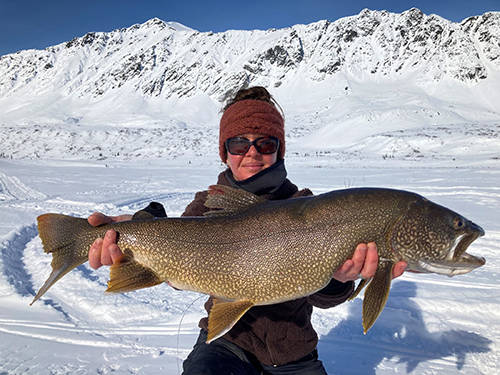
If you ask fisheries biologist Corey Schwanke, the Tangle Lakes system in the eastern Alaska Range is utopia for lake trout.
“Lake trout have easy access to ample shallow productive habitat, and they have easy access to deeper locations where they can find cold water,” said Schwanke, who has been working as a fisheries biologist in ADF&G’s Glennallen office for the past 30 years and also happens to be an avid lake trout angler. “That’s what makes Tangle Lakes so special.”
“In the middle of the summer when they’re forced out of the shallow water because it’s too warm, they can go to deeper, colder water,” he said. “That’s what lake trout need during the heat of summer - deep, cold water.”
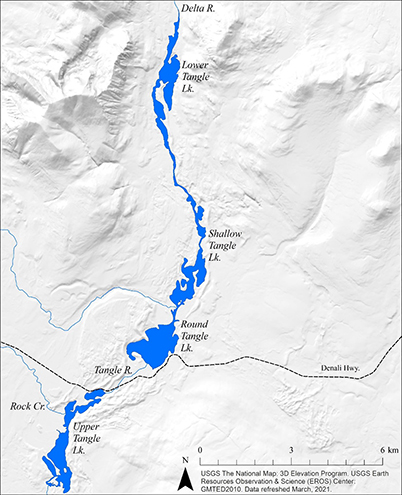 The series of four interconnected lakes – Upper, Round, Shallow and Lower Tangle Lakes – are located right off the Denali Highway, approximately 20 road miles west of Paxson and 180 road miles south of Fairbanks. Anglers can drive to the lakes and use boats or canoes to travel back and forth between lakes.
The series of four interconnected lakes – Upper, Round, Shallow and Lower Tangle Lakes – are located right off the Denali Highway, approximately 20 road miles west of Paxson and 180 road miles south of Fairbanks. Anglers can drive to the lakes and use boats or canoes to travel back and forth between lakes.
In addition to healthy populations of lake trout, some of which can top 20 pounds, Tangle Lakes also has a very healthy population of Arctic grayling which are almost always cooperative. Tangle Lakes also lures anglers with its breath-taking scenery. There’s not a prettier place you will find in Alaska to spend a day fishing.
Bountiful lake trout, easy access and stunning scenery all play a role in Tangle Lakes being the most popular lake trout fishery in the Tanana River drainage, and perhaps all of Interior Alaska.
Because the four lakes are connected by small streams that flow in and out of each lake, fisheries biologists like Schwanke for years have debated whether, from a management standpoint, lake trout in Tangle Lakes should be treated as one population or as multiple, independent populations. The answer to that question could help shape regulations such as bag and possession limits, use of bait and length restrictions.
Two years ago, Schwanke and fellow fisheries biologists Matt Albert from the Fairbanks ADF&G office set out to answer that question using radio telemetry to track fish to see if and how often they moved among lakes.
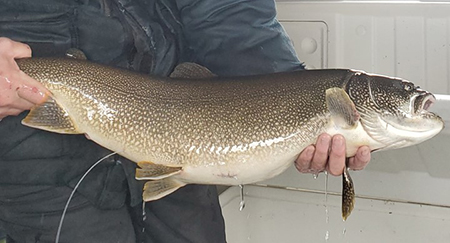
Biologists used hook and line gear and hookless, baited jug lines to catch 100 lake trout that were 16 inches or longer in the four different lakes in April and June 2022. Biologists surgically implanted small radio transmitters in each fish - 40 in Lower Tangle Lake, 22 in Shallow Tangle Lake, 25 in Round Tangle Lake and 13 in Upper Tangle Lake.
With the transmitters in place, biologists were then able to track the fish by airplane, boat and with solar-powered tracking stations set up between the lakes.
Operation Lake Trout
Surgically implanting radio transmitters in fish is common in fish research these days. It’s done with just about any fish big enough to hold a transmitter – Arctic grayling, burbot, lake trout, northern pike and salmon to name some of the species sport fish biologists in Fairbanks have conducted telemetry research on.
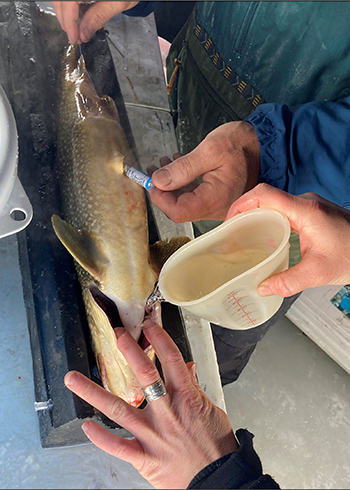
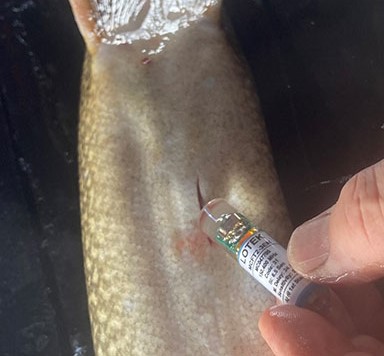 Once in the cradle, another member of the surgical team pours anesthetic-laced water over the fish’s gills to keep the gills irrigated and the fish sedated. The surgeon then makes a half-inch slit in the belly of the fish and inserts a small radio transmitter about the size of a AA battery with a foot-long wire antennae attached to it. A small hole is punched further back for the antenna.
Once in the cradle, another member of the surgical team pours anesthetic-laced water over the fish’s gills to keep the gills irrigated and the fish sedated. The surgeon then makes a half-inch slit in the belly of the fish and inserts a small radio transmitter about the size of a AA battery with a foot-long wire antennae attached to it. A small hole is punched further back for the antenna.
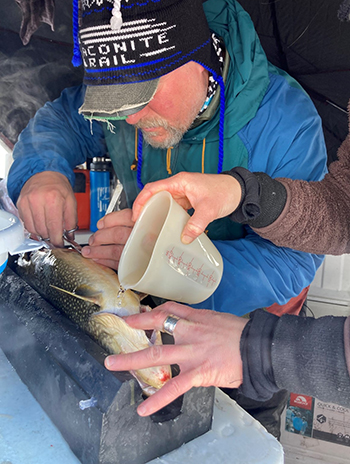
By this time, the attending nurse has switched over to pouring cold freshwater over the fish’s gills to keep them irrigated while the surgeon sews the belly up and the fish is moved to the recovery room – a plastic tub filled with freshwater.
To say that it’s an outpatient surgery would be an understatement.
“Generally, from the time the fish hits the cradle to the time we sew it up it’s less than two minutes,” said Albert, who estimates he has performed over 1,000 such surgeries. “By the time we’re done with the surgery they start wriggling and rolling upright.”
The only visible scar is the sewn-up incision on the fish’s belly and a thin, foot-long wire antennae protruding from behind the pelvic fin that allows biologists to track the fish with a radio receiver.
“We’re tagging fish when the water is cold so they heal up quickly and have good survival,” Albert said, noting they had a more than 90 percent post-surgery survival rate.
With the transmitters in place, biologists tracked the fish a total of 15 times by airplane and boat from late June to late October 2022 and late April to mid-October 2023. The transmitters are individually coded and biologists can identify each unique tag by its frequency using a radio receiver. Knowing that the fish might sometimes be in too deep a water to pick up a signal, biologists also set up three solar-powered tracking stations at the outlets of each lake to record when a fish happened to swim past.
The transmitters were turned off during the winter, from November to April, because biologists were confident the fish wouldn’t be moving back and forth between lakes during the winter months.
“The creeks (between the lakes) are all iced up and they’re pretty shallow; it would be difficult for them to swim through,” Schwanke said, adding that lake trout tend to be “pretty lethargic” during the winter months.
Sure enough, when biologists turned the transmitters on again in April, none of the tagged fish had changed locations from the previous November. That’s not to say some fish didn’t move to another lake and then return but “we have no evidence there was mixing (between lakes) in the wintertime,” Schwanke said.
Seasonal distribution
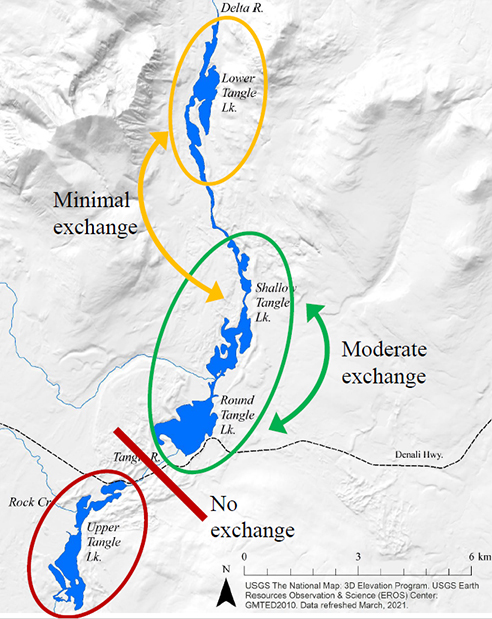
Biologists didn’t discover anything earth shattering as a result of the telemetry project. Based on results from a similar but smaller telemetry project conducted in 2004 and their experience working with lake trout, they already knew there was some mixing of fish from one lake to others, just not to what extent.
Here’s the gist of what biologists discovered:
- Of the 40 fish radiotagged in Lower Tangle Lake, 4 moved (10%) - all to Shallow Tangle Lake.
- Of the 22 fish radiotagged in Shallow Tangle Lake, 22 moved (100%) – all to Round Tangle Lake.
- Of the 25 fish radiotagged in Round Tangle Lake, 6 moved (24%) – all to Shallow Tangle Lake and one continued on to Lower Tangle Lake.
- Of the 13 fish radiotagged in Upper Tangle Lake, 2 moved (15%) – all to Glacier Gap Lake.
“What the telemetry is pointing toward is we have one independent population in Upper Tangle Lake; in Lower Tangle Lake there is some mixing of fish but they’re pretty segregated; and in Round and Shallow Tangle Lakes we have an intermixed population,” said Albert.
For Schwanke, the most informative aspect of the study was the seasonal movements of lake trout between Shallow Tangle Lake and Round Tangle. All 22 fish tagged in Shallow Tangle moved to Round Tangle in July and August, the hottest part of summer. And as its name implies, Shallow Tangle Lake is the shallowest of the four lakes. It makes perfect sense that when the water in Shallow Tangle Lake got too warm, the fish moved to deeper, colder Round Tangle Lake. It should be noted, though, that tracking data in June 2022 and June 2023 for Round and Shallow Tangle Lakes were nearly identical, suggesting those fish are faithful to those lakes during that time period.
“To me, that’s coolest thing we found is how they redistribute themselves seasonally between those two lakes,” Schwanke said. “Two weeks after ice out they seek the shallow, productive waters in Shallow Tangle Lake. Then, mid-summer, they seek Round Tangle and its deeper cooler water. Even in Lower Tangle Lake they will move from shallow more productive areas within the lake to the deep parts of the lake as summer progresses. That is probably why so few fish leave Lower Tangle Lake throughout the year- they have both habitat types within the lake.
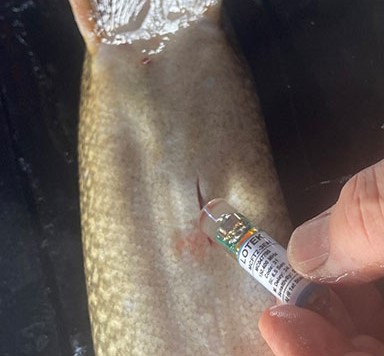
“Basically, these fish disperse in June, presumably to feed in shallow productive water, then seek out deeper summertime habitat associated colder water” he said.
The telemetry project also validated what biologists knew or suspected so they could proceed with a population estimate for the entire lake system.
“The results are kind of what we expected but we need something more concrete for a mark and recapture study than, ‘Well, we think this is what they’re doing,’” said Albert. “We had some indications there was movement, but we didn’t have the magnitude of that movement and we wanted to fine tune that.”
What does that mean in terms of management?
Based on the model ADF&G uses to determine sustainable harvest, if there were one population of fish the annual sustainable harvest would be 235 fish. If there are four different populations, the sustainable harvest would be 353 fish, a difference of almost 120 fish. The model is a tool, and its output is just one of several variables that goes into evaluating sustainability and fishing regulations.
Because of the amount of fishing pressure Tangle Lakes receives and the vulnerability of lake trout to even small changes in habitat and harvest, the more biologists know about the fish that inhabit those lakes, the better, Schwanke said. The sport fish regulations for lake trout in Tangle Lakes is already on the restrictive side, with a daily bag and possession limit of just one fish a day with no size limit compared to two fish a day in many lakes.
“All of this is going to better inform management,” he said.
Interesting tidbits
While biologists didn’t uncover any ground-breaking data, as often happens with telemetry projects, they did discover some interesting tidbits.
For example, two of the 13 fish that were tagged in Upper Tangle Lake traveled 12 miles up Rock Creek to go to Glacier Gap Lake, which surprised both Albert and Schwanke.
“They swam 12 miles up that dinky, rocky, high-gradient creek,” said Albert.
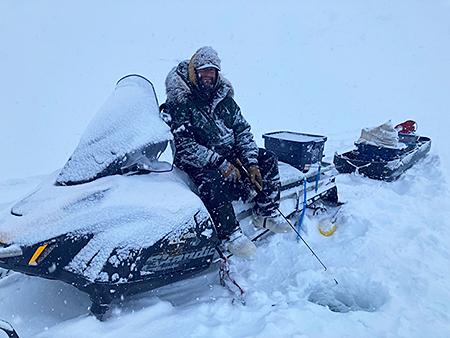
Why would two lake trout go to all that trouble?
“No idea,” Albert said. “That’s the cool thing about telemetry work. Ninety-nine percent of the time they do what you expect but a couple always do something completely different than the rest. Those are the fish you can learn from because they do something you never suspect.”
Now that he knows three lake trout – the two in this study and one in the past study - made the arduous trip from Upper Tangle Lake to Glacier Gap Lake up Rock Creek, the biologist in Schwanke wants to find out why. Were the fish spawned in Glacier Gap Lake and then traveled to Upper Tangle to rear before returning to spawn in Glacier Gap? Were they just seeking greener pastures?
“The fact we’ve documented three fish making the trip to Glacier Gap Lake, and none have ever been documented to take that short journey from Upper Tangle to Round Tangle where we know the two biggest spawning areas are – it’s remarkable,” Schwanke said. “There’s no barrier there. If a fish wanted to get there going downstream it would take less than five minutes and maybe 30 minutes upstream. They had two years to do that and none did it.”
“Those fish weren’t little; they’d spawned before,” Schwanke said.
Multi-purpose project
In addition to tracking fish movement between lakes, biologists also used telemetry data to try to identify spawning areas in the four lakes.
During the lake trout spawning period in late September, biologists tracked the fish at night with a boat. They cruised the shallows along the shoreline with a radio receiver and high-powered, submersible lights, as well as hand-held spotlights, looking for concentrations of fish or spawning activity.
“If they spawn in shallow water you can use a spotlight to pick up spawning activity,” Albert said.
If they found a concentration of fish they couldn’t’ see, they used small, mesh gillnets to catch fish and see if they were “ripe,” as Albert put it.
Biologists were able to identify three major spawning areas – one in Lower Tangle Lake and two in Round Tangle Lake. They listed four “suspected” spawning areas – two in Round Tangle, one in Upper Tangle and one in Lower Tangle. There were no spawning areas found in Shallow Tangle Lake.
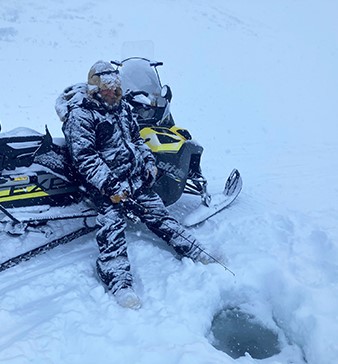
The Tangle Lakes telemetry project is also helping to inform the first-ever population estimate for the four lakes.
“It gave us the information we need to conduct an appropriate abundance estimate and that’s what we’re doing now,” said Schwanke.
Last spring, in two different tagging events in April and June, biologists caught and tagged a total of 502 lake trout ranging in size from 9 inches to 34 inches.
This year, biologists will return to Tangle Lakes for two recapture events – one through the ice in April and an open water event in June – to see how many fish they catch that were tagged during last year’s two tagging events. They will clip off a small fin – the adipose fin – on the back of each fish they catch so they will know if they catch it again. The population size can then be calculated based on the proportion of the fish caught with tags, and knowing how many fish were tagged last year.
For Schwanke, who prides himself on his fishing skills, the telemetry project also helped solve a years-old conundrum. He recalled several years ago how he and his family did well fishing for lake trout at Shallow Tangle Lake in consecutive years and returned for a third year with some Lower 48 friends to fish the lake. The fishing was much slower that year and they caught only two fish in four hours. As it turns out, the previous two trips had been in late June and this trip was after the 4th of July.
“I always suspected it had to do with distribution, but this study basically proves that the fish likely moved out of that lake by the time we fished it with friends,” Schwanke said. “It was a nice stretch of weather when my friends were up here.
“That’s one of things that’s kind of neat as a biologist, you go do these studies and it makes your personal experiences make sense,” he said. “Or you use your personal experiences to make sense out of your professional experiences.”
Lake Trout species profile
Subscribe to be notified about new issues
Receive a monthly notice about new issues and articles.
